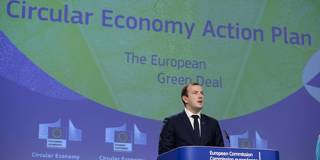If we do not abandon the prevailing “take-make-waste” pattern of global production and consumption soon, we will need the equivalent of almost three Earths to provide enough natural resources to sustain current lifestyles, and annual waste generation will increase by 70%. But there is a better way.
HONG KONG – Every year, 400 million tons of heavy metal, toxic sludge, and industrial waste are dumped into our waterways. At least eight million tons of plastic end up in our oceans. Some 1.3 billion tons of food – about one-third of all that is produced – is lost or wasted, while hundreds of millions of people go hungry. Our oceans are being overfished, our lands degraded, and biodiversity rapidly eroded. Meanwhile, devastating natural disasters – flash floods in Europe and China, forest fires in the United States, and locust infestations in Africa and the Middle East – are becoming more frequent.
The unsustainability of our linear “take-make-waste” pattern of global production and consumption has never been more obvious. In fact, if we do not abandon it by 2050, we will need the equivalent of almost three Earths to provide enough natural resources to sustain current lifestyles, and annual waste generation will increase by 70%. But there is a better way: we can embrace the circular economy.
The circular economy would decouple growth from the consumption of finite resources, keep products and materials in use, and regenerate natural systems. The European Union is already embracing this approach. Its Circular Economy Action Plan – a pillar of the European Green Deal – introduces legislative and non-legislative measures that would affect the entire life cycle of products, with a view not only to saving on materials, but also to creating jobs, improving human well-being, and protecting nature.

HONG KONG – Every year, 400 million tons of heavy metal, toxic sludge, and industrial waste are dumped into our waterways. At least eight million tons of plastic end up in our oceans. Some 1.3 billion tons of food – about one-third of all that is produced – is lost or wasted, while hundreds of millions of people go hungry. Our oceans are being overfished, our lands degraded, and biodiversity rapidly eroded. Meanwhile, devastating natural disasters – flash floods in Europe and China, forest fires in the United States, and locust infestations in Africa and the Middle East – are becoming more frequent.
The unsustainability of our linear “take-make-waste” pattern of global production and consumption has never been more obvious. In fact, if we do not abandon it by 2050, we will need the equivalent of almost three Earths to provide enough natural resources to sustain current lifestyles, and annual waste generation will increase by 70%. But there is a better way: we can embrace the circular economy.
The circular economy would decouple growth from the consumption of finite resources, keep products and materials in use, and regenerate natural systems. The European Union is already embracing this approach. Its Circular Economy Action Plan – a pillar of the European Green Deal – introduces legislative and non-legislative measures that would affect the entire life cycle of products, with a view not only to saving on materials, but also to creating jobs, improving human well-being, and protecting nature.